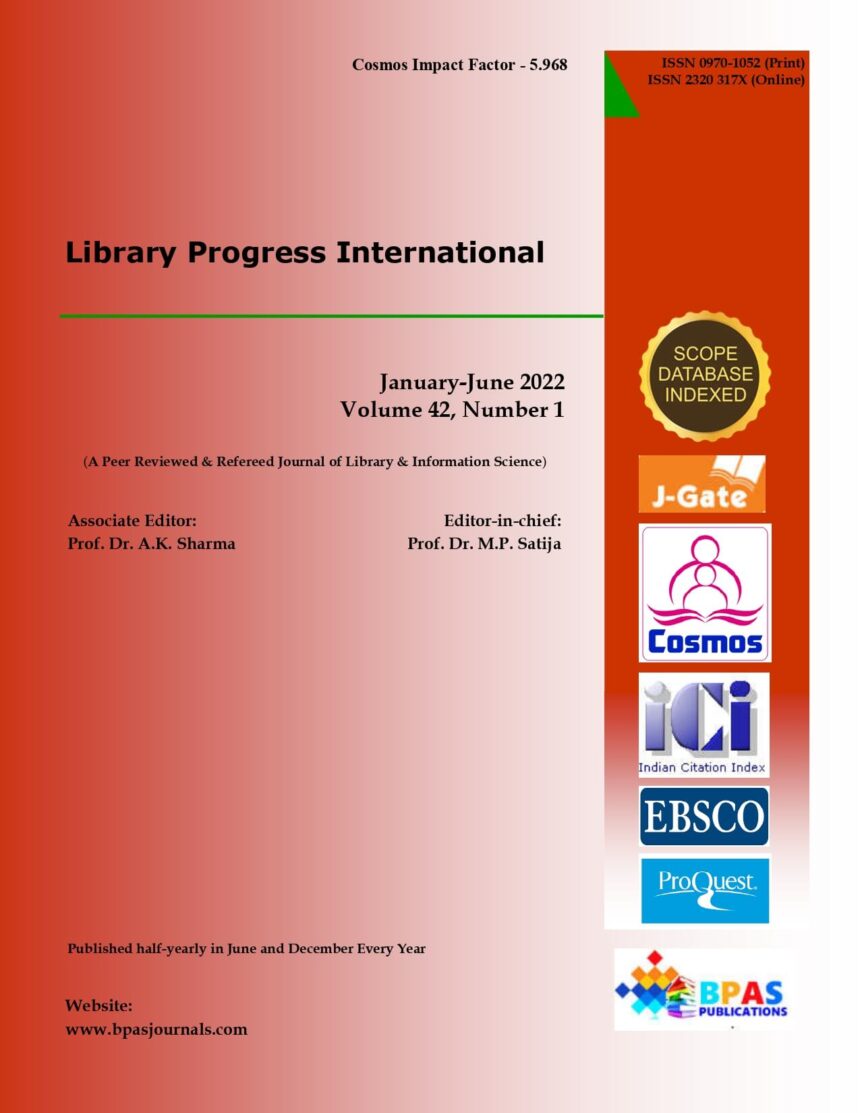Annona muricata (Medicinal Plant) Research: A Scientometric Analysis of Global Publications Output during 1991-2021
DOI:
https://doi.org/10.48165/bpas.2023.43.1.7%20Keywords:
Annona muricata, Publications, Degree of Collaborations, ScientometricsAbstract
Scientometric is defined as a technique for analysing and calculating different parameters which specify researcher's quantitative research output. This study examines scientometric analysis on Annona muricata (medicinal plant) by measuring and analysing the distribution of articles, year-wise, annual growth rate, authorship pattern, author productivity, relative growth rates, doubling time, degree of collaboration, ranked list of authors, and distribution of publications output. In this period of 31 years only 1236 publications were found. Publication of research in this field is not so much productive and only we have found that a maximum of 159 publications were published in 2020. Most prolific author is Hocquemiller, R. and at 1st rank in this field of Annona medicate. Brazil is at top position by publishing 269 publications followed by India (136). Universiti Putra Malaysia has taken lead by publishing 39 research papers. Conselho Nacional de Desenvolvimento Cientafico e Tecnola³gico funded 39 research publications only and at top position. 1194 publication are published in English language only. After analysing above parameters it has been concluded that research work on this field, in this long span is very less and therefore a huge research gap is found.
Downloads
References
Abdul Wahab, S. M., Jantan, I., Haque, M. A., & Arshad, L. (2018). Exploring the leaves of Annona muricata L. as a source of potential anti-inflammatory and anticancer agents. Frontiers in pharmacology, 9, 661. https://doi.org/10.3389/fphar.2018.00661
Almusawi, A.H.A., Al-Aradi H. J, and Hammadi K.J. (2017). The impact of salinity stress on morphological and anatomical aspects of water hyssop Bacopa monnieri (L.) Wettst grown in vitro. African journal of biotechnology, 16(15), 801-807.
Batcha, M. S. (2017). Research output analysis on robotic technology: A scientometric study. Indian Journal of Information Sources and Services, 7(1), 25-31.
Benzie, I.F.F. & Wachtel-Galor, S., (2011). Herbal Medicine: An introduction to its history, usage, regulation, current trend and research needs, in: Benzie, I.F.F., Wachtel Galor, S. (Eds.), Herbal Medicine: Biomolecular and Clinical Aspects, 2nd ed. Boca Raton (FL), CRC Press.
Bone, K., & Mills, S. (2012). Principles and practice of phytotherapy: modern herbal medicine. Elsevier Health Sciences.
Coria-Téllez, A. V., Montalvo-Gónzalez, E., Yahia, E. M., & Obledo-Vázquez, E. N. (2018). Annona muricata: A comprehensive review on its traditional medicinal uses, phytochemicals, pharmacological activities, mechanisms of action and toxicity. Arabian Journal of chemistry, 11(5), 662-691.
Gupta, B.M & Dhawan, S.M (2018). Robotics research in India: A scientometric assessment of Indian publications output
during 2007-2016. Journal of Scientometric research, 7(2), pp. 84-93.
Harvey, A. L. (1999). Medicines from nature: are natural products still relevant to drug discovery?. Trends in Pharmacological Sciences, 20(5), 196-198.
Husain, S and Mushtaq, M (2015). Research Assessment of Climate Change Data: A Scientometric Construct. Qualitative & Quantitative Methods in Libraries Special Issue, 183-194.
Langenberger, G., Prigge, V., Martin, K., Belonias, B., & Sauerborn, J. (2009). Ethnobotanical knowledge of Philippine lowland farmers and its application in agroforestry. Agroforestry systems, 76(1), 173- 194. https://doi.org/10.1007/s10457-008-
-3
Leatemia, J. A., & Isman, M. B. (2004). Insecticidal activity of crude seed extracts ofAnnona spp., Lansium domesticum and Sandoricum koetjape against lepidopteran larvae. Phytoparasitica, 32(1), 30-37. https://doi.org/10.1007/BF02980856
Merton, R. K. & Garfield, E. (1963). Forward to Little Science, Big science and Beyond by DJ de solla Price. 1963. Columbia University Press; New York.
Pinto, A.C.Q., Cordeiro, M.C.R.., Andrade, S.R.M., Ferreira, F.R., Filgueiras, H.A.C., Alves, R.E. and Kinpara, D.I. (2005). Annona species, International Centre for Underutilised Crops, University of Southampton, Southampton, UK.
Scientometrics (2008). Glossary of Thompson Scientific Terminology online. Retrieved from http://science.thomsonreuters.com/suppor t/patents/patinf/terms/>

